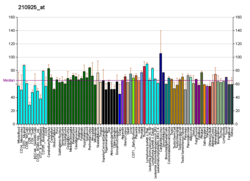CIITA
O CIITA é um gene humano que codifica uma proteína chamada transativador do principal complexo de histocompatibilidade de classe II.[3][4] Mutações nesse gene são responsáveis pela síndrome dos linfócitos nus, na qual o sistema imunológico está seriamente comprometido e não pode combater efetivamente a infecção.[3] O rearranjo cromossômico do CIITA está envolvido na patogênese do linfoma de Hodgkin e linfoma primário do mediastino de células B.[5]
Função
[editar | editar código-fonte]O RNAm do CIITA só pode ser detectado em linhas de células e tecidos positivos para a classe II do sistema de antígeno leucocitário humano (ALH). Esta distribuição de tecido altamente restrita sugere que a expressão dos genes ALH classe II está em grande parte sob o controle de CIITA.[6] No entanto, o CIITA não parece se ligar diretamente ao DNA.[6] Em vez disso, o CIITA funciona através da ativação do fator de transcrição RFX5.[7] Portanto, o CIITA é classificado como um coativador de transcrição.
A proteína CIITA contém um domínio de ativação transcricional ácido, 4 LRRs (repetições ricas em leucina) e um domínio de ligação a GTP.[8] A proteína usa a ligação GTP para facilitar seu próprio transporte para o núcleo.[9] Uma vez no núcleo, a proteína atua como um regulador positivo da transcrição de genes do complexo principal de histocompatibilidade classe II e é freqüentemente referida como o "fator de controle principal" para a expressão desses genes.[10][11]
Interações
[editar | editar código-fonte]Foi demonstrado que o CIITA interage com:
Referências
- ↑ «Doenças geneticamente associadas a CIITA ver/editar referências no wikidata»
- ↑ «Human PubMed Reference:»
- ↑ a b Steimle V, Otten LA, Zufferey M, Mach B. «Complementation cloning of an MHC class II transactivator mutated in hereditary MHC class II deficiency (or bare lymphocyte syndrome)». Cell. 75: 135–46. PMID 8402893. doi:10.1016/S0092-8674(05)80090-X
- ↑ Murphy, Kenneth (1 de junho de 2014). Imunobiologia de Janeway - 8.ed. [S.l.]: Artmed Editora
- ↑ Steidl C, Shah SP, Woolcock BW, Rui L, Kawahara M, Farinha P, Johnson NA, Zhao Y, Telenius A, Neriah SB, McPherson A, Meissner B, Okoye UC, Diepstra A, van den Berg A, Sun M, Leung G, Jones SJ, Connors JM, Huntsman DG, Savage KJ, Rimsza LM, Horsman DE, Staudt LM, Steidl U, Marra MA, Gascoyne RD. «MHC class II transactivator CIITA is a recurrent gene fusion partner in lymphoid cancers». Nature. 471: 377–81. PMC 3902849
 . PMID 21368758. doi:10.1038/nature09754
. PMID 21368758. doi:10.1038/nature09754
- ↑ a b Mach B, Steimle V, Reith W. «MHC class II-deficient combined immunodeficiency: a disease of gene regulation». Immunological Reviews. 138: 207–21. PMID 8070816. doi:10.1111/j.1600-065X.1994.tb00853.x
- ↑ a b Scholl T, Mahanta SK, Strominger JL. «Specific complex formation between the type II bare lymphocyte syndrome-associated transactivators CIITA and RFX5». Proceedings of the National Academy of Sciences of the United States of America. 94: 6330–4. PMC 21049
 . PMID 9177217. doi:10.1073/pnas.94.12.6330
. PMID 9177217. doi:10.1073/pnas.94.12.6330
- ↑ Raval A, Howcroft TK, Weissman JD, Kirshner S, Zhu XS, Yokoyama K, Ting J, Singer DS. «Transcriptional coactivator, CIITA, is an acetyltransferase that bypasses a promoter requirement for TAF(II)250». Molecular Cell. 7: 105–15. PMID 11172716. doi:10.1016/S1097-2765(01)00159-9
- ↑ Harton JA, Cressman DE, Chin KC, Der CJ, Ting JP. «GTP binding by class II transactivator: role in nuclear import». Science. 285: 1402–5. PMID 10464099. doi:10.1126/science.285.5432.1402
- ↑ Harton JA, Ting JP. «Class II transactivator: mastering the art of major histocompatibility complex expression». Molecular and Cellular Biology. 20: 6185–94. PMC 86093
 . PMID 10938095. doi:10.1128/MCB.20.17.6185-6194.2000
. PMID 10938095. doi:10.1128/MCB.20.17.6185-6194.2000
- ↑ LeibundGut-Landmann S, Waldburger JM, Krawczyk M, Otten LA, Suter T, Fontana A, Acha-Orbea H, Reith W. «Mini-review: Specificity and expression of CIITA, the master regulator of MHC class II genes». European Journal of Immunology. 34: 1513–25. PMID 15162420. doi:10.1002/eji.200424964
- ↑ a b Voong LN, Slater AR, Kratovac S, Cressman DE (abril de 2008). «Mitogen-activated protein kinase ERK1/2 regulates the class II transactivator». The Journal of Biological Chemistry. 283 (14): 9031–9. PMC 2431044
 . PMID 18245089. doi:10.1074/jbc.M706487200
. PMID 18245089. doi:10.1074/jbc.M706487200
- ↑ Tzortzakaki E, Spilianakis C, Zika E, Kretsovali A, Papamatheakis J (dezembro de 2003). «Steroid receptor coactivator 1 links the steroid and interferon gamma response pathways». Molecular Endocrinology. 17 (12): 2509–18. PMID 12933903. doi:10.1210/me.2002-0439
- ↑ a b Hake SB, Masternak K, Kammerbauer C, Janzen C, Reith W, Steimle V (outubro de 2000). «CIITA leucine-rich repeats control nuclear localization, in vivo recruitment to the major histocompatibility complex (MHC) class II enhanceosome, and MHC class II gene transactivation». Molecular and Cellular Biology. 20 (20): 7716–25. PMC 86349
 . PMID 11003667. doi:10.1128/mcb.20.20.7716-7725.2000
. PMID 11003667. doi:10.1128/mcb.20.20.7716-7725.2000
- ↑ Nekrep N, Geyer M, Jabrane-Ferrat N, Peterlin BM (agosto de 2001). «Analysis of ankyrin repeats reveals how a single point mutation in RFXANK results in bare lymphocyte syndrome». Molecular and Cellular Biology. 21 (16): 5566–76. PMC 87278
 . PMID 11463838. doi:10.1128/MCB.21.16.5566-5576.2001
. PMID 11463838. doi:10.1128/MCB.21.16.5566-5576.2001
- ↑ Raval A, Weissman JD, Howcroft TK, Singer DS (janeiro de 2003). «The GTP-binding domain of class II transactivator regulates its nuclear export». Journal of Immunology. 170 (2): 922–30. PMID 12517958. doi:10.4049/jimmunol.170.2.922
- ↑ Al-Kandari W, Jambunathan S, Navalgund V, Koneni R, Freer M, Parimi N, Mudhasani R, Fontes JD (janeiro de 2007). «ZXDC, a novel zinc finger protein that binds CIITA and activates MHC gene transcription». Molecular Immunology. 44 (4): 311–21. PMC 1624858
 . PMID 16600381. doi:10.1016/j.molimm.2006.02.029
. PMID 16600381. doi:10.1016/j.molimm.2006.02.029
- ↑ Al-Kandari W, Koneni R, Navalgund V, Aleksandrova A, Jambunathan S, Fontes JD (junho de 2007). «The zinc finger proteins ZXDA and ZXDC form a complex that binds CIITA and regulates MHC II gene transcription». Journal of Molecular Biology. 369 (5): 1175–87. PMC 1963517
 . PMID 17493635. doi:10.1016/j.jmb.2007.04.033
. PMID 17493635. doi:10.1016/j.jmb.2007.04.033


